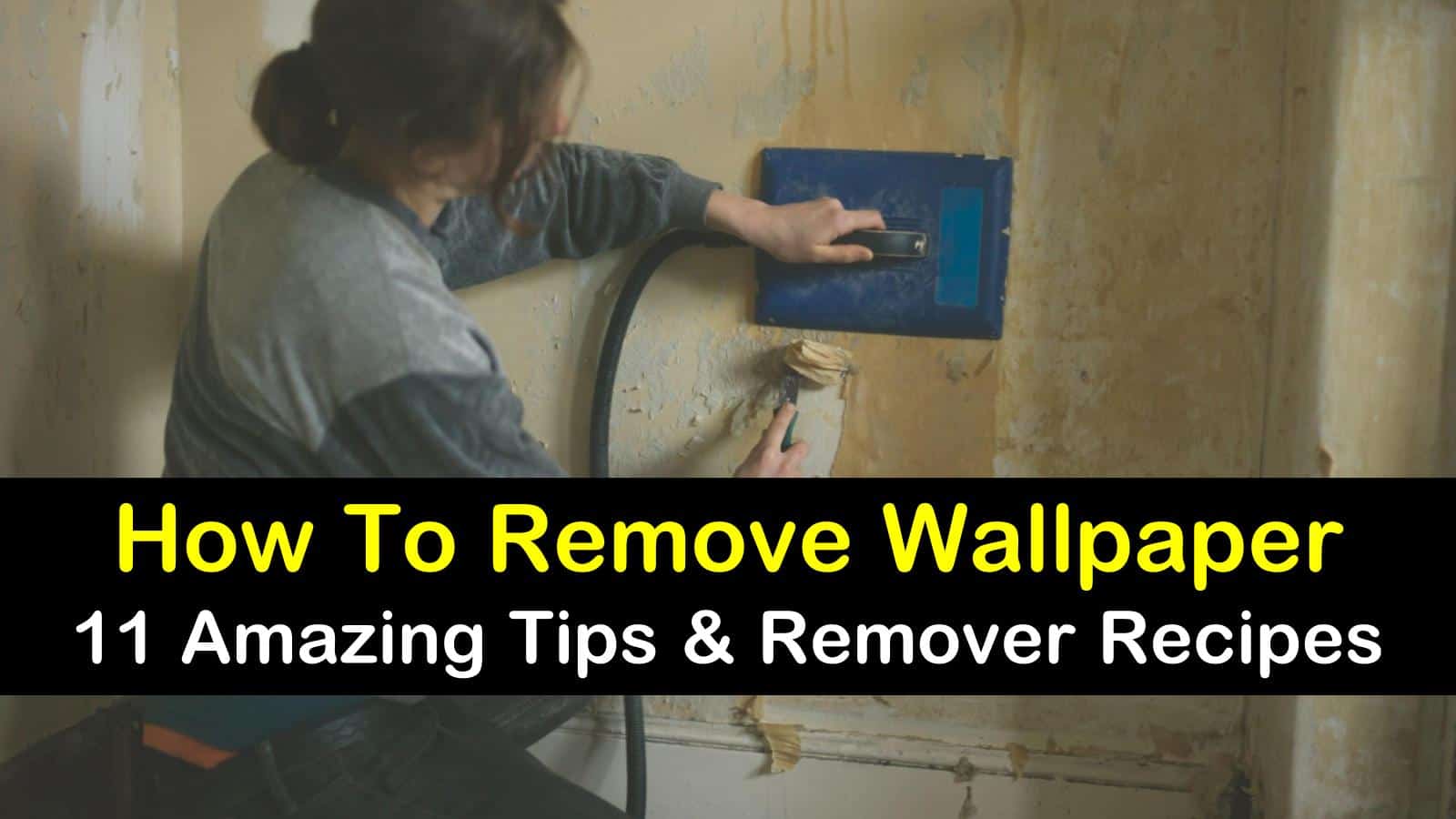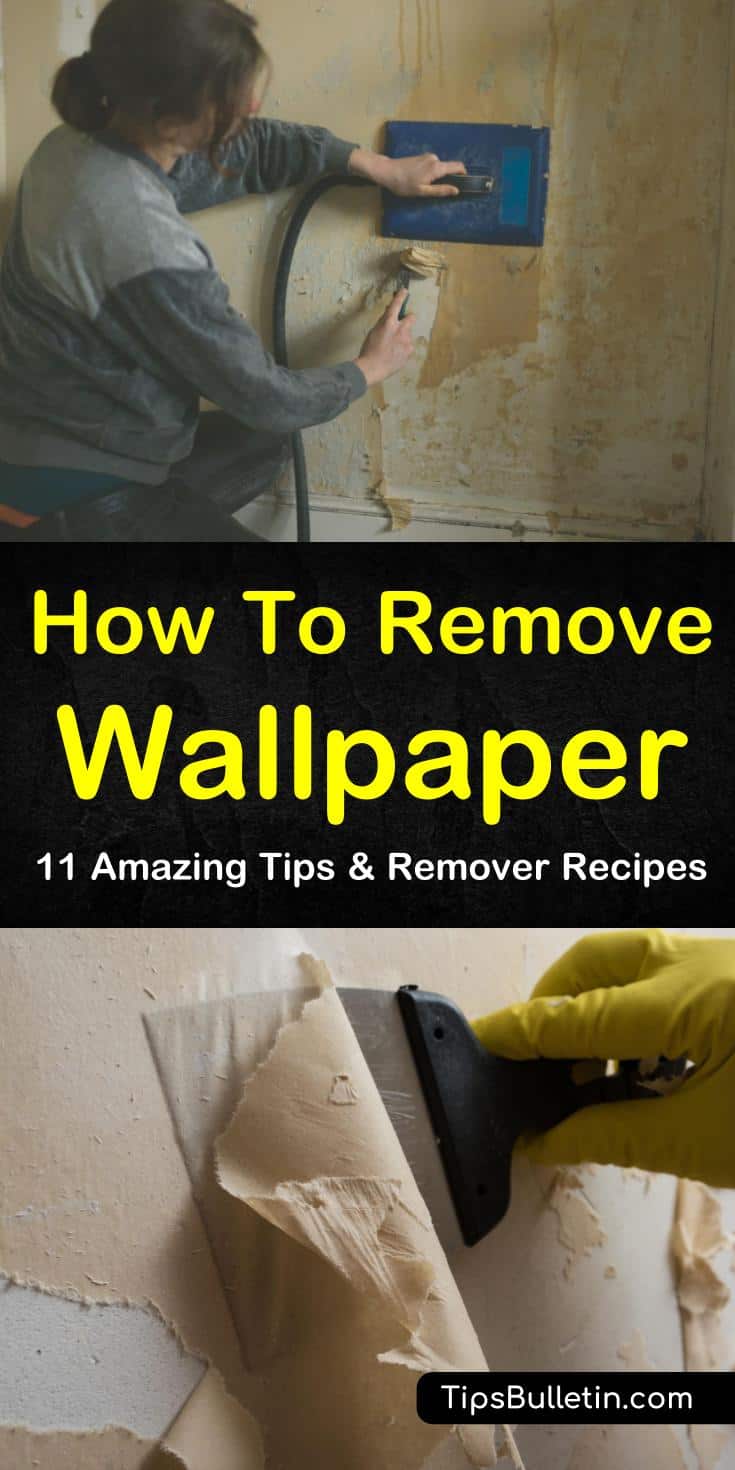DIY home improvement projects can be a great way of creating a look in your home that you love while also raising the value of your house. On the other hand, these same projects can lead to frustration and many headaches. We’ll show you how to remove wallpaper efficiently, with fewer problems.
The act of removing old wallpaper from the wall can be messy, tedious, and time-consuming, yet necessary when putting up new wallpaper or when painting. Unfortunately, there is no easy way around it unless you use removable wallpaper.
This process can be more difficult for someone who has never had to tackle with wallpaper removal in the past. Because of this, we decided to create a list of the best techniques for removing wallpaper efficiently.

- How to Take Off Wallpaper
- What to Do Before You Remove the Wallpaper
- DIY Wallpaper Removal
- How to Remove the Wallpaper Backing
- How to Remove Stubborn Wallpaper Paste
- How to Remove Wallpaper Using a Steamer
- How to Remove Wallpaper Using Stripper
- Remove Wallpaper Using Vinegar
- Removing Wallpaper with Fabric Softener
- Removing Wallpaper Using Dish Soap
- How to Remove Wallpaper with Dish Soap and Fabric Softener
- How to Clean Walls after Removing Wallpaper
How to Take Off Wallpaper
You’ll need to remove all of the old wallpaper and residue before you can apply any new wall covering to ensure that the wall has a clean, smooth surface for applying new wallpaper or paint.
The following techniques include a variety of DIY wallpaper removal methods that you can use to remove wallpaper. If you select one and don’t like the results you get, try something else.
What to Do Before You Remove the Wallpaper
There are several steps to take before you begin removing any wallpaper. Doing the following steps ahead of time will ensure that you don’t forget anything and will also save you time.
We recommend that you set aside several days or a long weekend such as Labor Day weekend for this project, as it will probably take a few days to complete.
Wallpaper Removal Prepping
Remove any pictures or wall hangings off the walls, making sure to remove all nails and screws. Remove outlet covers, switch plates, heating/air conditioning duct covers, curtain rods, and anything else that is attached to the wall.
Place a piece of tape onto the backside of each item and wrap the proper screws to the tape for easy reassembly.
Carefully remove baseboards and molding. Move any furniture or obstructions away from the walls. Place a drop cloth on the floor area to make clean up easier. If you plan on steaming the wall to remove a border from the wall, cover the exposed outlets with painter’s tape to protect them.

Inspect the walls for an area with any loose wallpaper. Use a utility knife to pull some of the paper away so you can get a look at what you are dealing with beneath the surface.
You may discover that you’ve only been looking at a top layer of wallpaper with two or three other layers beneath it. Doing this will help you to determine the process you need to take for removal.
DIY Wallpaper Removal
Now that you have gotten the walls and room prepped, you can get down to the nitty-gritty. The following is a basic method for removing wallpaper without using a chemical stripper or a steamer, as well as to remove a wallpaper border.
Removing Wallpaper
Whether you are trying to remove vinyl wallpaper or another type, the objective of this step is to pull the top paper off the wall without removing the backing. Begin by finding a loose area of the wallpaper. This may be in the corner of the room or around the outlet area. Use a putty knife to gently lift the paper upwards.
When there is enough paper to grab, carefully lift the facing off the wall by gently pulling towards you at a slow and steady pace. Use constant and steady pressure. You may be able to remove entire sheets of top paper in one motion.
How to Remove the Wallpaper Backing
After you have carefully ripped off the top paper off the wall, you will be left with the backing. The backing cannot be pulled easily off the wall due to the adhesive.
The following process shows you how to remove the backing and adhesive. It can also be used for how to remove wall decals that stubbornly refuse to let go of the wall.
After the top layer of paper has been removed from the wall, use a sponge to get the backing wet. Use the hottest water you can. While wearing gloves to protect your hands from the hot water, sponge the water onto the surface of the wall in sections.
Plaster walls can handle hot water better than drywall. If you are working on drywall, do not let the area sit for more than 15 minutes. Once the backing has softened, use the putty knife to gently scrape the backing off the wall.
Make sure that the putty knife has rounded and flexible edges so that you do not damage the wall. Wetting and scraping old wallpaper also works best if you do it in small sections.
How to Remove Stubborn Wallpaper Paste
Even after all of that, there may still be some stubborn backing and remaining paste on the wall, and you may even find old stains that have been covered up for a long time.
The following will help you to remove that leftover gunk and show you the best way to clean stains off walls that were hidden by wallpaper.
Spray some gel stripper onto the areas of the wall with the remaining backing and paste. Allow it to sit for15 to 20 minutes. Use the scraper to remove all the gel and backing paste beneath, being careful not to gouge the wall. Use warm water to rinse the wall until clean.
How to Remove Wallpaper Using a Steamer
Using a wallpaper steamer rather than a sponge and hot water can make the process of removing wallpaper a little less tedious. The steamer will release a burst of hot steam into sections of the wallpaper, loosening the adhesive for easy removal.
Check your owner’s manual for special instructions before use. First, try and peel away as much of the top paper by hand as possible. Hold the steamer against the wall for 10-20 seconds to loosen the paper.
Once you have removed the top paper, you’ll need to remove the sticky backing. You can use a utility knife or scoring tool to score the backing in small areas. Doing this will enable the steam to work its way beneath the wallpaper.
Start at the ceiling in sections and make your way to the floor so any dripping water will work to your advantage. Start by steaming one area to loosen the adhesive. Follow this by using the putty knife to scrape and peel away the backing. Repeat this process until the entire wall is completed.
How to Remove Wallpaper Using Stripper
Walls that have many layers of wallpaper plastered on them or very old wallpaper may require a more intense type of wallpaper remover as a last resort. There are a variety of wallpaper strippers that contain chemicals that break down the adhesive holding the paper to the wall.
Generally, wallpaper strippers come in a spray bottle that is ready to use. If not, follow the instructions on the particular wallpaper stripper you have purchased. Spray or apply the solution using a sponge to small sections of the wallpaper and allow it to sit for the recommended amount of time.
Use the scraper to scrape and peel the loosened backing away from the wall. Continue moving along section by section until the wall is free of wallpaper.
Remove Wallpaper Using Vinegar
The following method is ideal if you prefer to use non-toxic solutions. The main ingredient in this wallpaper remover is vinegar, which acts as a natural acidic solution to help gently dissolve and loosen the adhesive. You can even use vinegar to make homemade mopping solutions.
Mix equal parts water and vinegar in a spray bottle. Once you have removed as much of the front paper as possible, spray the vinegar solution in small areas at a time and allow it to soak into the backing for about 15 minutes.
Use the scraper to lift the paper backing away from the wall. Repeat this process section by section until the wall is bare. Vinegar is also an excellent cleaner for washing painted walls and cleaning numerous other surfaces in the home.
Removing Wallpaper with Fabric Softener
The ingredients in the fabric softener will break down wallpaper adhesive, making it easier for you to peel and remove from the wall.
Mix equal parts water and liquid fabric softener in the spray bottle. You can also use a garden sprayer for this process. Spray a section of the wallpaper and allow it to sit for several minutes to loosen the paper backing. Use the paint scraper to peel off the wallpaper. Repeat the process in the next section.
Removing Wallpaper Using Dish Soap
The following procedure can be used for those stubborn areas of wallpaper that refuse to be removed. The combination of soap and hot water work together to remove wallpaper glue.
Fill a bucket with water, and add a few squirts of dish soap. Use a sponge saturated with soapy water to wet small sections of the wallpaper. Allow the solution to work at loosening the glue for a few minutes and then peel away the wallpaper.
How to Remove Wallpaper with Dish Soap and Fabric Softener
The following process will show you how to remove wallpaper glue from walls. This method will also work wonders to get tape off walls and other sticky messes. The combination of dish soap, water, and fabric softener removes wallpaper glue.
Combine the water, fabric softener, and dish soap in a spray bottle or garden sprayer. Spray one section of the wallpaper backing and let sit for a few minutes to loosen the glue. Use a scraper to pull the wallpaper away from the wall. Repeat the process in sections until the paper is gone.
How to Clean Walls after Removing Wallpaper
Before applying new wallpaper or paint to the wall, be sure that the walls are cleaned of any leftover adhesive, glue, or residue. The following process will show you how to clean walls after removing wallpaper. These ingredients can also be used as an all natural bathroom cleaner.
For the way to remove wallpaper glue and the last bits of wallpaper, mix equal parts water and vinegar in a spray bottle. Spray the surface of the walls and use the sponge to wipe away any leftover wallpaper adhesive residue and dirt.
Although it can be a bit more challenging because of the uneven surface, you can also use vinegar to clean an interior brick wall or those made from concrete blocks. Clean and sanitize almost any household surface with vinegar.
Unfortunately, removing wallpaper may not get any easier or less messy until someone comes out with a remarkable wallpaper removal invention. Fortunately, there are some techniques and hacks that can be used to do that job with fewer headaches and frustration using the right tools and know-how.

We hope these techniques give you a better understanding on how to remove wallpaper and that you’ll share these wallpaper remover recipes with your family and friends on Pinterest.